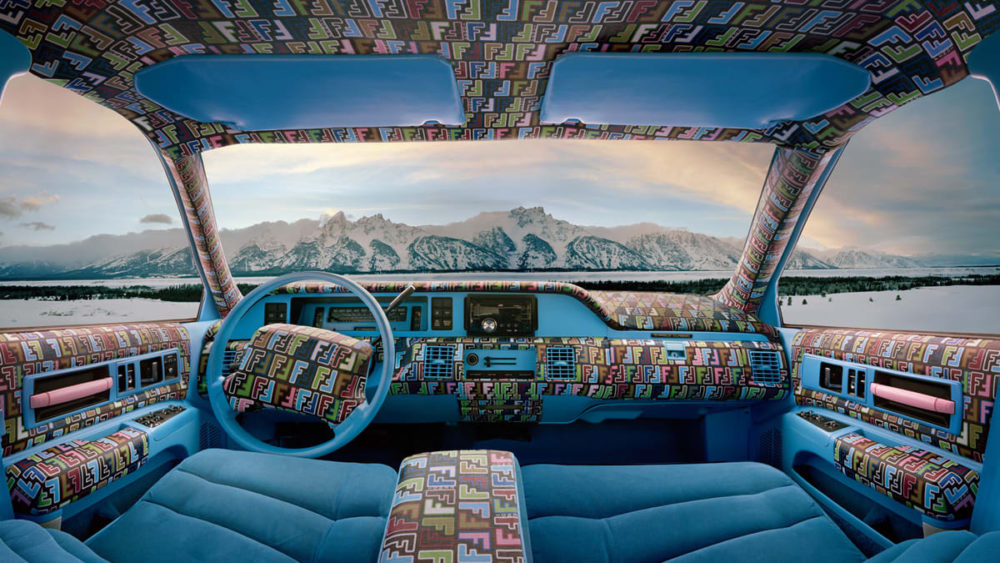
- Source: Daily Beast
- Author: Lizzie Crocker
- Date: September 09, 2011
- Format: DIGITAL
Luis Gispert New Photographs, ‘Deception’: Custom Counterfeit Creations
In a new show opening in New York on Thursday, photographer Luis Gispert documents the phenomenon of custom counterfeiting.

Courtesy of Luis Gispert and Mary Boone Gallery
In February 2008, New York City police cracked down on Canal Street’s “Counterfeit Triangle,” a tourist trap where street vendors peddled designer knockoffs. Rolex personally thanked Mayor Michael Bloomberg for “recognizing the pervasive crime of counterfeiting.” But in Miami, American artist Luis Gispert took the counterfeit crackdown as inspiration—and used it to discover a black-market goldmine.
Gispert was photographing car interiors for a separate project when he stumbled upon a kitschy white Cadillac Escalade, its seats upholstered in fake material from Takashi Murakami’s 2009 collaboration with Louis Vuitton. While the owner showed off his pimped-out ride, the wheels turned in Gispert’s head. “I figured there had to be so many cars with counterfeit interiors,” he tells The Daily Beast.
This inspired a two-year “obsessive quest” to document a subculture of people crafting custom designs from counterfeit materials. Gispert attended car shows across the country and captured interiors bedazzled with logos, from a Burberry-upholstered BMW to a Gucci-themed Mercedes. Honing in on the culture itself brought Gispert to more-intimate spaces, like the home of a Florida-based drug dealer, whose bedroom was decorated with Versace’s signature Greek Key motif. Gispert’s photographic journey is the subject of an upcoming solo exhibition, Decepcion, opening at the Mary Boone Gallery in New York on Sept. 8.
He spent a year capturing cars before turning his lens on the owners themselves—many of whom had closets filled with backpacks, sneakers, and jackets custom-made from fake designer materials. Gispert’s project evolved to incorporate portraits of men and women modeling counterfeit fashion, such as a DJ clad in a pleather MCM jumpsuit. A message becomes clear: this is a community of people compelled to identify themselves with a brand—an instinct Gispert attributes to class anxiety. “Designer brands connote wealth and a certain class that these people want to be part of,” he says.
Unlike Canal Street vendors, Gispert’s subjects aren’t trying to pass off their creations as authentic. “These people are appropriating the material, the actual logos and fabrics, but they’re not trying to mimic high fashion,” he explained. One photograph from the series features a woman wearing a Louis Vuitton dress that Gispert described as “some kind of nightgown, flamenco hybrid.” It looks nothing like Louis Vuitton couture, yet it’s splattered with the designer’s cult logo. “In a way these people are hijacking signs of wealth, bastardizing logos and turning them into something completely unique.”
Designer customization was born in the early 1980s, when a haberdasher named Dapper Dan began selling one-of-a-kind Louis Vuitton boots and $8,000 custom Gucci jackets out of his boutique in Harlem. “He was likely cutting up actual Gucci bags and using the materials to make jackets and luxury car interiors,” said Gispert. Dapper Dan’s clientele consisted of drug dealers—until LL Cool J and Mike Tyson took the street trend mainstream.
“This seems to be one of those moments when high and low are meeting in the middle,” Gispert said of the custom-counterfeit phenomenon he encapsulated in the exhibition. “Whatever it is, it has a cultural currency that works for these people.”
Luis Gispert will exhibit his new series of photographs on Sept. 8 at Mary Boone Gallery in New York City.

